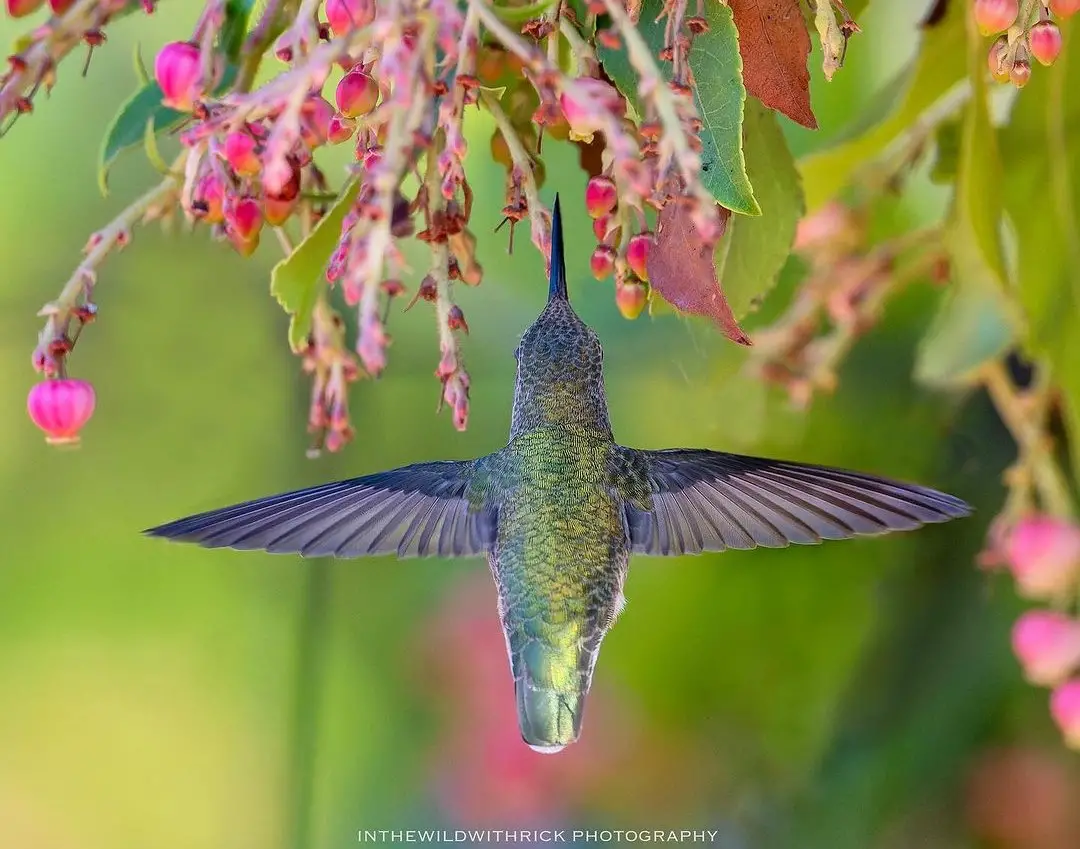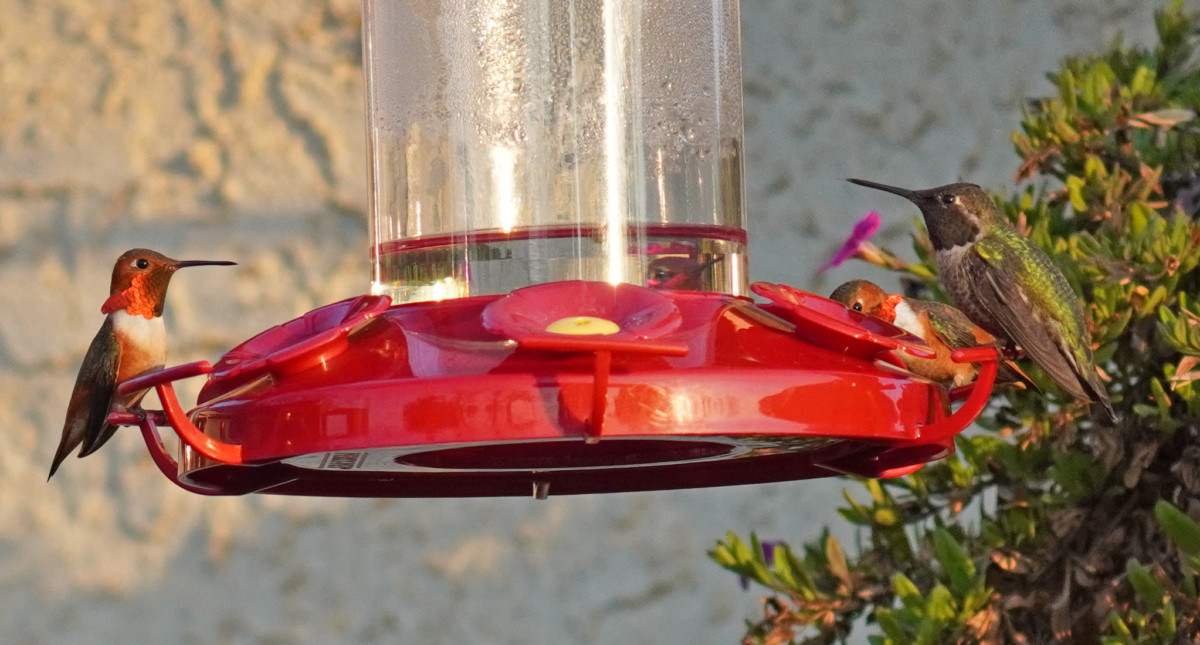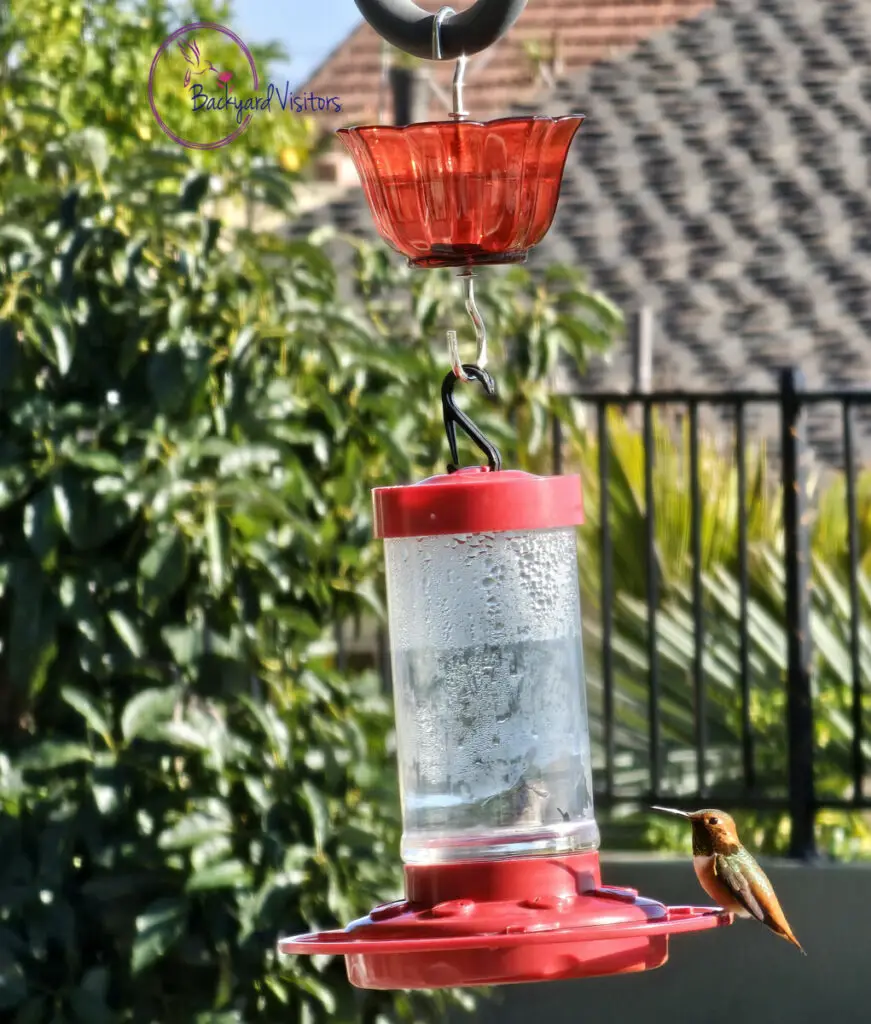This post contains affiliate links.
Discover if hummingbirds return to the same place each year. Explore the fascinating migration patterns and fidelity to nesting sites that draw these avian marvels back annually.
With their iridescent feathers and mesmerizing flight patterns, hummingbirds have long captivated the hearts of enthusiasts everywhere. A question that often flutters through the minds of avid birdwatchers is whether these avian marvels exhibit homing instincts akin to their larger migratory counterparts.
This article explores the astounding navigational abilities of hummingbirds, delving into the compelling evidence and factors behind their annual return to familiar territories. Join us as we uncover the secrets of these tiny travelers and their unwavering fidelity to their chosen haunts.
Do Hummingbirds Come Back to the Same Place Every Spring Migration?
As the winter’s chill softens to the gentle embrace of spring, many hummingbird aficionados find themselves asking, “Do hummingbirds come back to the same place each year?” These enchanting avian travelers, known for their remarkable migratory habits, have sparked curiosity among observers with their punctual return to gardens and feeders across North America.
The answer, steeped in the wonders of nature, is a resounding “yes”. With a fidelity to location that rivals the most dedicated of navigators, hummingbirds return to the very same areas they frequented in previous years.
Banding studies have provided a wealth of insight into this behavior, revealing that not only do they return every year, but indeed the same hummingbirds return, oftentimes to the very same trees or feeders where they were first spotted.
Read my article: 3 Reasons Why Hummingbirds Are Banded
Their ability to return to the same place is a testament to their astonishing navigational skills. Despite the epic journey these tiny birds undertake during their southward migration and back, hummingbirds migrate with a precision that sees them revisiting their favored habitats each spring migration.

Photo by: IntheWildwithRick
Such a phenomenon brings wonderment and raises numerous questions about the mechanisms underlying their homing ability. Do hummingbirds, with their boundless energy and iridescent plumage, possess an innate GPS that guides them to familiar locations? While science continues to unravel these mysteries, what remains clear is the joy and anticipation that their returning brings to enthusiasts.
At the core of this recurrent spectacle is the notion of site fidelity. Hummingbirds come back, traversing thousands of miles, to exploit the reliable food sources and suitable breeding grounds that they remember. The area they choose must, therefore, provide abundant nectar and insects, safe perching, and nesting locations to ensure their survival.
Interestingly, upon the time of spring migration, it is not uncommon to witness the same hummingbirds return to stake their claim, vigorously defending their territory from rivals.
Read my article: Hummingbird Migration: Familiar Journeys to Previous Locations
Given these remarkable migration patterns, the keen observer will contemplate how to ensure that returning hummingbirds find a hospitable environment upon their arrival.
Planting native flowers, maintaining clean feeders, and offering fresh water encourages not only the same place to be revisited by these feathery gems but also the continued flourishing of hummingbird populations. This is essential because, with each passing year, the cycle of annual returns remains a delicate balance with their ecosystems.

Hot Lips Salvia
To celebrate the fidelity of these winged wonders, many hummingbird lovers prepare for the return of these birds with a ritualistic fervor. Setting up feeders in the same spot every year and keeping records of specific birds visited within their area becomes not just a hobby, but a dedicated contribution to citizen science.
It is in the quiet moments of stillness, as the early morning sun glints off a hovering visitor’s plumage, that we find reassurance in the knowledge that indeed the same hummingbirds return, as faithful to their migratory paths as the stars are to the night’s sky.
Below is a list of ways a hummingbird knows to come back to the same place every year in order of importance:
- Genetic Instincts: Hummingbirds have an innate migratory pattern encoded in their genes that compels them to return to the same location each year.
- Internal Biological Clock: The changing daylight hours trigger hormonal changes in hummingbirds, signaling them to start their migration at consistent times each year.
- Geomagnetic Navigation: Hummingbirds use the Earth’s magnetic field as a guide to navigate long distances, helping them locate the same areas annually.
- Visual Landmarks: As they migrate, hummingbirds recognize mountains, rivers, and other geographic features to guide them back to familiar feeding and breeding grounds.
- Star Navigation: At night, hummingbirds use the position of the stars as a navigational aid, a technique observed by many migratory birds.
- Solar Navigation: By using the sun as a compass during the day, hummingbirds maintain their migratory path and return to familiar locations.
- Wind and Weather Patterns: Paying attention to prevailing winds and weather conditions assist hummingbirds in their journey, often leading them back to the same spot.
- Memory and Learning: Individual hummingbirds learn and remember specific locations with abundant resources and return to them based on successful foraging experiences in past years.
- Social Learning: Young hummingbirds follow and learn from older, experienced migrants during their first journey, which helps them return to the same migratory destinations subsequently.
How Do Hummingbirds Migrate and Return to the Same Location Annually?
One of the most remarkable traits of hummingbirds is their astounding migratory precision. Enthusiasts often marvel at the fact that Ruby-throated hummingbirds follow the same migration routes every year with unwavering consistency.
These tiny avians possess an incredible internal compass, guiding them across vast distances to return every year to the very same place they left. As we delve into the science and spectacle of how hummingbirds migrate, one cannot help but be awestruck by their innate navigational skills.
Intrinsically tied to the changing of seasons, hummingbirds do migrate to ensure their survival, venturing from Central America and Mexico to the lush regions of North America, where they breed and raise their young.

Each year, these iridescent beauties traverse up to thousands of miles during spring and fall migrations. The experiences gained from the initial journey seem to be etched into a hummingbird’s memory, enabling them to return to the same feeders, gardens, and even specific branches.
It is as if every beat of their rapidly flapping wings is a step on a path well-known, drawing them back to the places they have deemed as home.
But how do hummingbirds know when and where to migrate? It is believed that changes in daylight length and temperature cues initiate the migration process.
Ruby-throated hummingbirds, in particular, display a remarkable fidelity to their breeding sites. In fact, males are known to come back to the exact same territory each year, a phenomenon observed and cherished by many birdwatchers. This repeated homing behavior suggests a level of site loyalty that is quite extraordinary in the avian world.
Once the males secure their preferred area, they engage in an aerial display to attract a mate, leading to the next generation of hummingbirds. The importance of returning to the same locality is highlighted in this reproduction phase, as familiar surroundings offer known resources and nesting sites crucial for the survival of hummingbird eggs and chicks.
It is during this time that the cycle of life for hummingbirds truly reveals itself, as their continuity hinges on their ability to navigate back to these nurturing environments.
Despite their small size, hummingbirds are hardy. Their migration is not just about returning to the same place but also about enduring the journey. The dynamics of their migration are an interplay of instinct, environmental cues, and perhaps even a magnetic connection to the Earth’s fields, although the latter is still a subject of ongoing research.
They have an uncanny ability to gauge when it is time to leave, ensuring their timely arrival in North America each spring.
Hummingbirds do return to the same location annually, a testimony to their exceptional navigational prowess. This habitual return not only emphasizes the importance of conserving habitats along their migration routes but also results in the joyous anticipation for bird lovers who eagerly await their feathery friends’ return every year.
That hummingbirds come back to the same place is not just a marvel of natural instinct—it is a bold affirmation of the resilience and complexity of these mesmerizing creatures.
Unveiling the Mystery: Why Do Hummingbirds Return to the Same Place Each Year?
Behold the fluttering sprites of our backyards, hummingbirds—these vibrant avian acrobats that captivate our hearts with their insatiable energy. It is a question that both novice and seasoned bird enthusiasts ponder: Do hummingbirds come back to the same place every year?
Hummingbirds do have a fantastic memory and will return to the same feeder every year, gracing the same gardens with their iridescent plumage and incredible aerial dances. One may scrutinize their delicate frames and marvel, how do these tiny creatures, embarking on a perilous journey across vast distances, return to the same haven each year?
Much like clockwork, the anticipation builds among those who cherish these feathered jewels, as the time approaches for the hummingbirds’ annual return. Consistency in their habitat preference is not a mere coincidence; their internal compass guides them with astonishing precision.

Why do hummingbirds place such importance on returning to the same locale? Research indicates that hummingbirds are creatures of habit, eager to reclaim their previous nectar-rich territories. This preferential behavior ensures they maximize their energy refueling stops, particularly critical during breeding season when demands escalate exponentially.
What pushes these diminutive navigators to come back to their favored perches with such loyalty? Energy efficiency and site fidelity play monumental roles in the lives of hummingbirds.
When hummingbirds return, it is a testament to their remarkable navigational skills, honed by their acute spatial memory. They can recollect the position of every flower, feeder, and even the very same branches they used for perching the year before. The mental maps stored in their pint-sized brains steer them across continents back to the same feeders, the same blooms, the same safe shelters they left behind.
Their yearly pilgrimage is not solely for sustenance. Hummingbirds also exhibit a charming reliance on the camaraderie of humans. They do not simply return; they engage with the people who have anticipated their comeback.
Do hummingbirds, those tiny, fearless voyagers, remember the individuals who replenish their sugary banquets? Anecdotal evidence from countless hummingbird aficionados supports the heartwarming notion that they do recall the human presence associated with their feeding spots.
This bond, subtle as it may be, underscores the mutual benefit of their annual rendezvous—it is a partnership, one wherein hummingbirds and humans alike, eagerly await the moment they can resume their shared connection.
The phenomenon of hummingbirds returning to the same place is not solely about survival; it reflects a profound link between life’s cycles and the enigmatic forces of nature. In a world brimming with change, having the comfort of consistently knowing that the return of hummingbirds each year remains constant is a refreshing feeling.
It is a cycle that reinforces the allure of these winged dynamos, ignites joy in observers, and solidifies the reason why we must continue to safeguard their habitats. For in doing so, we not only secure the future of hummingbirds but also the enchanting ritual of their return, every spring, to the very same places we, and they, call home.
Ensuring the Continual Return of Hummingbirds to Your Same Backyard
Hummingbird enthusiasts often ask, “Do hummingbirds come back to the same place every year?” It is a fascinating aspect of these winged wonders where they do come back and return to familiar grounds.
Individual hummingbirds are known to return to the same backyard each year, showing fidelity to places where they have previously found suitable habitats and resources. By understanding the migratory patterns of hummingbirds, one can take steps towards ensuring their return, transforming your garden into a hummingbird haven.
Creating an inviting environment with a reliable hummingbird feeder is one strategy for ensuring return. These feeders should be cleaned regularly and filled with fresh nectar to provide the necessary energy for these high-metabolism creatures.
Moreover, the feeder’s placement plays a crucial role. It should be located in a safe and sheltered area to attract returning individual hummingbirds that are in search of a consistent food source. With attention to details like these, enthusiasts can eagerly anticipate the annual spectacle of hummingbirds coming back to the same backyard.
Alongside the presence of a feeder, the cultivation of native plants that hummingbirds prefer will further cement your garden’s appeal to these avian visitors. Rich in nectar, flowers such as Cigar Plants, Salvias, Trumpet vines, Bee balms and Columbines serve dual functions. They provide nourishment for the birds and act as natural beacons signaling the presence of food.

Cigar Plant – (Cuphea ignea)
Photo by: Kevin Walsh
Over time, these natural cues become ingrained in the memories of individual hummingbirds, making it more likely they will return to the same sanctuary year after year.
It is noteworthy that when hummingbirds do return, they come back with remarkable precision. Studies show that hummingbirds remember specific feeders and plants from previous years, which suggests that they have excellent spatial memory.
This underscores the importance of maintaining consistency in your backyard setup, as changes will potentially disrupt the cycle of the hummingbirds’ return. By keeping everything as close to the same as possible, you heighten the chances of hummingbirds returning to the same place every year.
Natural fencing and water sources, like misters or birdbaths, can also help in ensuring return by providing a sanctuary from predators and a spot for bathing, which is a staple in hummingbird daily rituals.
This brightly colored red bubble-top water feature is sure to attract hummingbirds, especially in the hot summer months.
Read my article: How to Help Hummingbirds in Hot Weather
Likewise, avoiding pesticides and opting for organic gardening techniques contributes to a safe, toxin-free environment for these delicate birds, encouraging them to return to the same backyard where they will not face chemical threats.
Hummingbirds do indeed come back to the same place every year. It requires a thoughtful and committed approach to ensure they continue to do so. As devotees of these fantastic creatures, our efforts in creating and sustaining a welcoming landscape including the feeders, the flowers, the shelter—are crucial in welcoming our beloved hummingbirds back each year.
By optimizing our backyards to their needs and habits, we will find joy in the remarkable loyalty of these birds and marvel as they return, as if by clockwork, to grace our same gardens year after year.
Check out my other posts on Hummingbird Questions
Frequently Asked Questions
Q: Do hummingbirds return to the same place every year?
A: Yes, hummingbirds display an impressive level of site fidelity and are known to return annually to the same gardens, feeders, and even the same trees they have frequented in the past. Their remarkable navigational skills allow them to journey thousands of miles and pinpoint previous locations with incredible precision.
Q: How do hummingbirds navigate during migration?
A: While the full scope of their navigation system is not completely understood, research suggests hummingbirds use an internal compass guided by the sun’s position, changes in daylight length, temperature cues, and possibly even the Earth’s magnetic fields to help them migrate back to the same place each year.
Q: What can I do to ensure hummingbirds come back to my garden or feeder each year?
A: You can encourage hummingbirds to return by consistently providing clean feeders filled with fresh nectar, planting native nectar-rich flowers, ensuring a supply of fresh water, and maintaining a safe habitat free from pesticides. Consistency in your backyard setup is key.
Q: Do hummingbirds remember human feeders and the people who fill them?
A: Anecdotally, many bird enthusiasts report behavior that suggests hummingbirds remember and even recognize individual humans associated with their feeding spots. Their ability to remember specific feeders and locations indicate they may also associate those places with the people who maintain them.
Q: How far do hummingbirds migrate, and why is this journey vital?
A: Some hummingbirds, like the ruby-throated hummingbird, migrate up to thousands of miles between Central America and North America to access abundant food supplies and optimal breeding sites. This annual journey is crucial for the survival of their species. Their fidelity to returning to the same place ensures a continuity of resources and safe habitats for raising their young.
Happy Hummingbird Watching!
Backyard Visitors participates in affiliate programs which compensate us for referring traffic.
